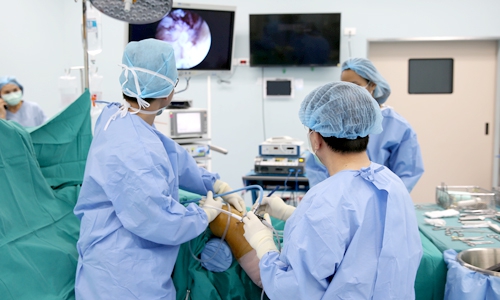
I’ve heard about laparoscopic and arthroscopic surgery a lot. Can you describe how it’s done?
Laparoscopic surgery is a modern surgical technique widely used around the world. It has been in use in Thailand for around 40 years. The main instrument is the endoscope, which is a long, thin ( < 4 mm diameter ), flexible tube with a light and camera at one end. The endoscope is inserted into the knee through a small incision about the size of a grain of rice. It allows doctors to see inside the joint. The camera projects an image of the joint onto a screen, which can be used to generate still images or videos. The tube also allows liquids, heat, and fragments to drain out. At first, doctors look inside the joint, diagnose the problem, and decide what type of surgery you need, if any. If you do need surgery, your surgeon will insert special tools through other small incisions called portals. These specialized tools can be used to cut, shave, grasp, vacuum, drill, or anchor stitches into bone. There are also instruments that can adjust the pressure inside the joint, which can stabilize the joint and help stop bleeding.
So, how is laparoscopic surgery better than conventional surgery?
Laparoscopic surgery clearly has a much smaller incision compared to conventional open surgery, which required an incision at least 2 inches long. The size of that incision in open surgery would depend on how deep the joint is. Yet, even with a large incision, the visibility of the joint is still not as good as having a camera inside. Laparoscopic surgery also has the benefit that the camera can bend and tilt, allowing doctors to see hard to reach locations. Because of these factors, laparoscopic surgery is more beneficial when the joint’s cavity is large enough to fit a camera, when there are hard to reach sections, or when the joint is located deep inside the body. Accordingly, this approach is widely used for the knees, shoulders, hip, elbows, ankles, and wrists.
Can laparoscopic surgery be used in knee replacement?
Currently, it’s not possible and is unlikely to be so in the future. The reason is simply because of the large size of the knee replacement parts. To be done laparoscopically, the knee replacement parts would have to be broken down into tiny pieces and reassembled inside, which is just not feasible. Therefore, knee replacements require large incisions.
Well, how is it that I’ve heard that laparoscopic surgery is commonly used in athletes for knee ligament reconstruction?
This is a very complicated issue, so it might require more explanation that what we have here. But, basically, there is a ligament reconstruction technique in which an artificial or transplanted ligament can be inserted to replace a damaged ligament that is beyond repair. In the laparoscopic procedure, the replacement ligament is attached to the bone near where the original ligament was, serving as a replacement. If an athlete has gone through the proper procedures, this may be option. However, in Thailand we still prefer not to use artificial or transplanted ligaments donated from a tissue donor (called allografts), since they are expensive and/or there is a risk of spreading disease. As such, the replacement ligament would need to be harvested from cartilage and bone from another site in the patient’s own knee (called autograft).
Does laparoscopic surgery require anesthesia?
All types of surgery require some form of anesthesia—whether it’s local or general. However, whether general anesthesia (i.e., you’re unconscious) is necessary depends on the location of the joint receiving the endoscopy and the technique of the anesthesiologist. Most surgeries on the limbs can be completed without general anesthesia. To do that, an injection at the sciatic nerve causes numbness in the limb. Because the patient is not unconscious, he/she can discuss with the doctor about any decisions during the surgery. Also, once the surgery is complete, the patient will be able to resume eating sooner as compared to general anesthesia. Still, there may still be some side effects, including drowsiness, nausea, or vomiting that is generally associated with any anesthesia. Another potential side effect of the local anesthesia approach with spinal injection is that it may cause headaches or make it difficult to urinate immediately after surgery. However, for those that aren’t afraid, being conscious during the surgery may provide a rare opportunity to see inside the joint, as the images are shown on the screen.